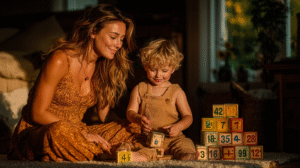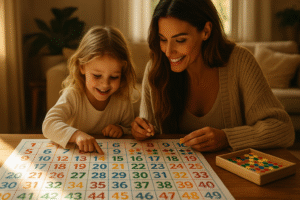
Why Estimation Is the Most Important Math Skill You’re Not Teaching
Why Estimation Is the Most Important Math Skill You’re Not Teaching Estimation is the math superpower your child might be

Last Tuesday, I watched my 6-year-old daughter Emma struggling with basic addition homework. Meanwhile, her little brother started stacking LEGO bricks and counting. That’s when I realized: LEGO wasn’t just play—it was a gateway to learning through powerful, hands-on math experiences.
As a former middle and high school math teacher, I had a moment of clarity watching my own kids: LEGO math activities weren’t part of our curriculum—yet they were exactly what we needed. These bricks weren’t just toys in our house – they were untapped mathematical goldmines ready to spark deep learning through play.
After fifteen years of teaching mathematics and now navigating the beautiful chaos of homeschooling two young learners, I’ve discovered that LEGO math activities are a brilliant way to bridge the gap between abstract math concepts and concrete understanding. These colorful plastic bricks offer endless opportunities to explore number sense, patterns, geometry, and critical thinking—the very skills that lay the foundation for lifelong STEM success.

Starting with simple LEGO math activities focused on counting builds confidence and foundational number sense. I love spreading out LEGO bricks by color and having my kids count each group, then compare quantities using mathematical language like “more than,” “less than,” and “equal to.”
Creating number towers has become our go-to morning routine. Emma builds towers with exactly seven red bricks while Jake focuses on smaller numbers like three or four. These kinds of LEGO math activities reinforce one-to-one correspondence by touching each brick while counting—building strong mental connections between symbols and quantities.
We also play number recognition games using sticky notes on LEGO bins, asking kids to place the right number of bricks in each one. This activity not only builds number sense but also helps with motor skills and direction-following.
Teacher Mom Tip: Use different LEGO sizes to emphasize that quantity matters more than size—five big bricks still equals five!
Among our favorite LEGO math activities are hands-on addition and subtraction games. Manipulating bricks turns abstract concepts into something kids can physically see and touch. For example, combining three red bricks and two blue ones lets kids experience what “3 + 2 = 5” actually looks like.
Story problems become engaging adventures with LEGO characters: “Five LEGO people ride in a car, then two get out at the park.” It’s a memorable way to teach subtraction and develop storytelling skills alongside math.
By building scenes that mirror real-world situations—like party guests arriving or animals leaving a farm—LEGO math activities help kids apply mathematical thinking in relevant, meaningful ways.
Teacher Mom Tip: Have your child talk through their steps as they play. Verbalizing builds strong internal problem-solving habits.
Pattern play is one of the most underestimated LEGO math activities for developing early algebra skills. We begin with AB patterns (like red-yellow-red-yellow) and move on to ABC or ABBA sequences. These simple activities encourage logical thinking and predictive reasoning.
Sometimes we take turns: I start a pattern, and the kids continue it. Emma enjoys creating complex patterns, while Jake practices easier ones—both developing critical skills at their level.
Three-dimensional pattern challenges add another layer of engagement. Building towers, walls, or even sculptures gives kids the chance to work on math, logic, and spatial reasoning all at once through purposeful LEGO math activities.
Teacher Mom Tip: Take pictures of finished patterns so your kids can recreate or expand on them later—great for independent learning!
Geometry is everywhere in LEGO math activities. We create triangles, squares, and hexagons with bricks while discussing sides, angles, and vertices. Building these shapes helps children grasp geometric properties hands-on.
Symmetry challenges are another favorite. I build half of a structure, and the kids mirror the other half. It sharpens visual processing and gives them a deeper understanding of balance and proportion.
We also measure with LEGO bricks—comparing furniture length, book widths, and toy heights using bricks as non-standard units. These LEGO math activities naturally develop early measurement skills.
Teacher Mom Tip: Planning with graph paper adds a layer of pre-construction thinking, connecting 2D visuals to 3D models.
STEM-focused LEGO math activities combine logic, design, and math in playful ways. We might challenge each other to “build a bridge using exactly twelve bricks” or “make the tallest tower that doesn’t fall.” It builds creativity alongside problem-solving.
From measuring to bar graphing LEGO data—like how many red bricks were used in each project—kids start to see math as a tool for understanding the world around them.
We also explore fractions through LEGO bricks by comparing different-sized pieces and understanding ratios—like four small bricks equal one large one. These LEGO math activities simplify complex math concepts through touch and play.
Teacher Mom Tip: Capture your child’s creations with quick photos and labels—it creates a math portfolio full of pride and growth.
LEGO math activities are more than playful fun—they’re powerful tools for developing confident, capable learners. Whether you’re homeschooling or adding weekend enrichment, these ideas create lasting math connections.
The true beauty of LEGO math activities lies in how they meet children exactly where they are—inviting growth, curiosity, and joy. With just one or two LEGO-focused activities each week, you’ll watch their math confidence grow brick by brick.
Every time I see my kids naturally turning to LEGO for learning, I’m reminded: the best math lessons often come disguised as play.

Why Estimation Is the Most Important Math Skill You’re Not Teaching Estimation is the math superpower your child might be

Boost Early Math Skills Through Music | Fun and Proven Learning Strategies for Kids “Can we sing the counting song

Counting Made Fun: Use Sticker Charts to Teach Early Math at Home “I don’t want to count anymore!” My four-year-old’s
*Also read:
25 Brilliant LEGO Math Activities to Build Number Sense and STEM Skills at Home
Teach Kids to Tell Time: The Clock Game Every Parent Should Try at Home